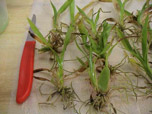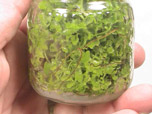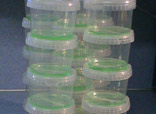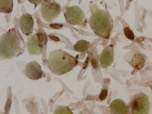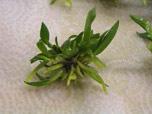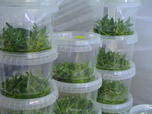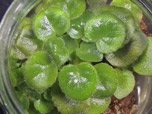Material Safety Data Sheet
PPM (Plant Preservative Mixture™)
Download PDF file
IDENTIFICATION
Chemical Name: PPM™ (Plant Preservative Mixture)
Chemical Family: Proprietary
CAS#: Proprietary (Several #s)
Synonyms: N/A
DOT Information: Not Corrosive (pH = 3.7)
| Hazard | Rating | Scale |
| Oral toxicity | 4 | 4=INSIGNIFICANT/NONE |
| Eye/Skin Toxicity/Irritation | 3 (Caution) | 3=MODERATE |
| Fire | 4 | 2=HIGH |
| Reactivity | 4 | 1=EXTREME/CORROSSIVE |
The above rating is Plant Cell technology’s toxicity rating. It incorporates some EPA criteria.
COMPANY IDENTIFICATION
Plant Cell Technology, Inc.
1823 Jefferson Street, NW
Washington, DC 20036, USA
+1.202.788.8522 ext. 123
PPM™ is a trademark of Plant Cell Technology, Inc.
1. PHYSICAL DATA
Appearance: Clear
Color: Amber to clear
State: Liquid
Odor Characteristic: Mild, inoffensive odor
pH: 3.0 – 4.0
Solubility in Water: Completely soluble
2. INGREDIENTS
PPM™ is a proprietary chemical product.3. FIRE AND EXPLOSION HAZARD DATA
Flash Point- Auto-ignition Temperature Not Applicable
- Lower Explosive Limit Not Applicable
- Upper Explosive Limit Not Applicable
Unusual Hazards
- Combination generates toxic fumes of the following: hydrogen chloride, nitrogen oxides, sulfur oxides.
- Use extinguishing media appropriate for surrounding fire.
- Wear self-contained breathing apparatus (pressure-demand MSHA/NIOSH approved or equivalent) and full protective gear.
- Use water spray to cool containers exposed to fire. Minimize exposure. DO NOT breathe fumes. Contain run-off.
4. HEALTH HAZARD DATA
Inhalation- Inhalation of vapor or mist can cause the following: irritation to nose and throat.
- Material can cause the following: corrosion to dyes – permanent, irreversible eye injury.
- Skin irritation effects can be delayed for hours. Material can cause the following: irritation to the skin, allergic contact dermatitis.
- Material is harmful if swallowed.
5. FIRST AID MEASURES
Inhalation- Move subject to fresh air. Give artificial respiration if breathing has stopped.
- If swallowed, IMMEDIATELY call and see a physician. Never give anything by mouth to an unconscious person.
- IMMEDIATELY flush eyes with a large amount of water for at least 15 minutes. Wash affected skin areas thoroughly with soap and water. Remove and wash contaminated clothing thoroughly. Do not take clothing home to be laundered. Discard contaminated shoes, belts and other articles made of leather. Get prompt medical attention.
- MATERIAL HAS A pH of 3.0-4.0. It may be advised to induce vomiting. Possible mucosa damage may contraindicate the use of gastric lavage. Measures against circulatory hock and convulsions may be necessary.
6. REACTIVITY DATA
- This material is considered stable under specified conditions of storage, shipment and/or use.
- Thermal decomposition may yield the following: hydrogen chloride, sulfur dioxide, oxides of nitrogen.
- Hazardous Polymerization: Production will not undergo polymerization.
- Incompatibility: Avoid contact with the following: oxidizing agents, reducing agents, amines, mercaptans.
7. SPILL OR LEAK PROCEDURES
Dilute with 100x water. Rinse decontaminated solution to a chemical sewer.8. SPECIAL PROTECTION INFORMATION
Personal Protection- Wear compatible, chemically resistant gloves.
- Material has a pH of 3.0 – 4.0. If exposed to material during clean-up operations IMMEDIATELY remove all contaminated clothing and wash exposed skin areas with soap and water. See SECTION 6, First Aid Measures, for further information.
- Protective clothing made of the following material should be worn to avoid skin contact: butyl, rubber or nitrite.
- Use local exhaust ventilation with a minimum capture velocity of 150 ft/min. (0.75 m/sec.) at the point of dust or mist evaluation. Refer to the current edition of Industrial Ventilation: A Manual or Recommended Practice published by the American Conference of Governmental Industrial Hygienists for information on the design, installation, use and, maintenance of exhaust systems.
- Facilities storing or utilizing this material should be equipped with an eyewash facility and a safety shower.
9. HANDLING AND STORAGE
Storage Conditions- The maximum recommended storage temperature for this material is 55° C/131° F. The minimum recommended storage temperature for this material is 0° C/32° F. Store in a well ventilated area. Do not store this material in containers made of steel.
- See Exposure Controls/Personal Protection prior to handling. Since emptied container retain product residue (vapors and/or liquid) follow all MSDS and label warning even after container is emptied.
10. REGULATION INFORMATION
- Workplace Classification: This product is considered non-toxic.
11. TOXICOLOGICAL INFORMATION Oral LD50 – rat:30g/kg
- Eye/Skin Irritation – rabbit: moderate irritation/insult, reversible damage
- Sensitization Data: Human – Allergic contact dermatitis possible.
12. ECOLOGICAL INFORMATION
- Not Available.
13. DISPOSAL CONDITIONS
- Dispose of PPM™-containing media as you would non-PPM™ media. Items that are contaminated with full strength PPM™ should be rinsed liberally (100x) in water. See Item #8 above.
14. TRANSPORTATION INFORMATION
- US DOT Hazard Class = Non-Toxic. Classified as a skin irritant.
The information contained herein relates only to the specific material identified. Plant Cell Technology, Inc. believes that such information is accurate and reliable as of the date of this material safety data sheet, but no representation, guarantee or warranty express or implied, is made as the accuracy, reliability, or completeness of the information. Our company urges persons receiving this information to make their own determination as to the information’s suitability and completeness for their particular application.

